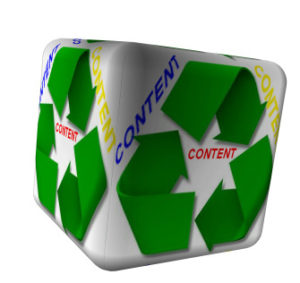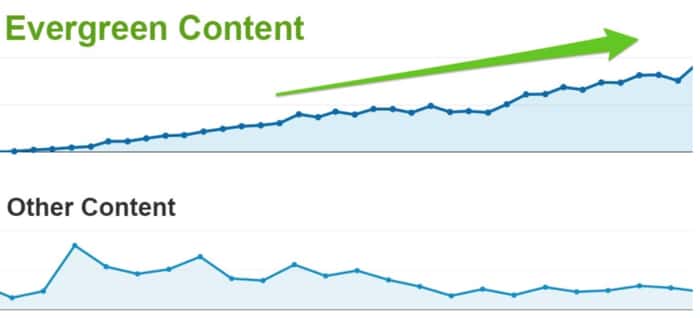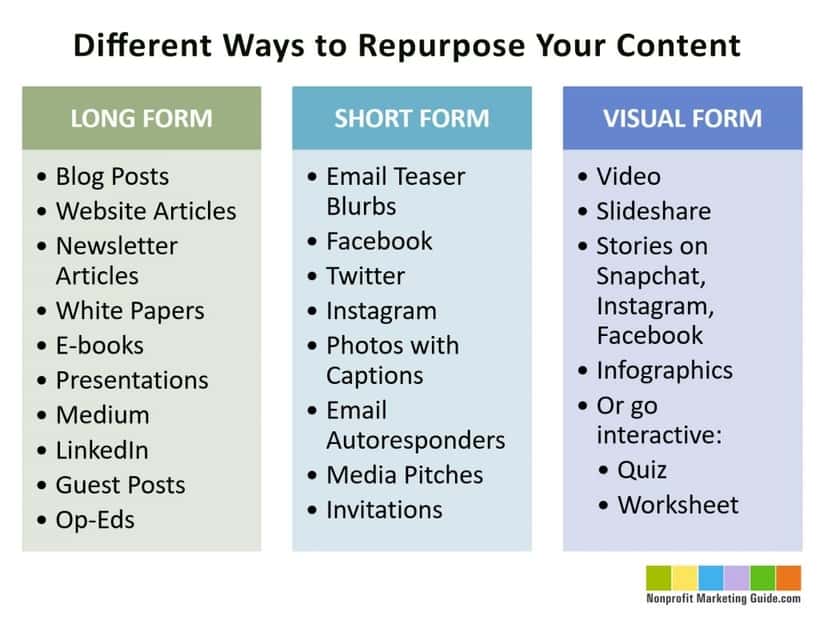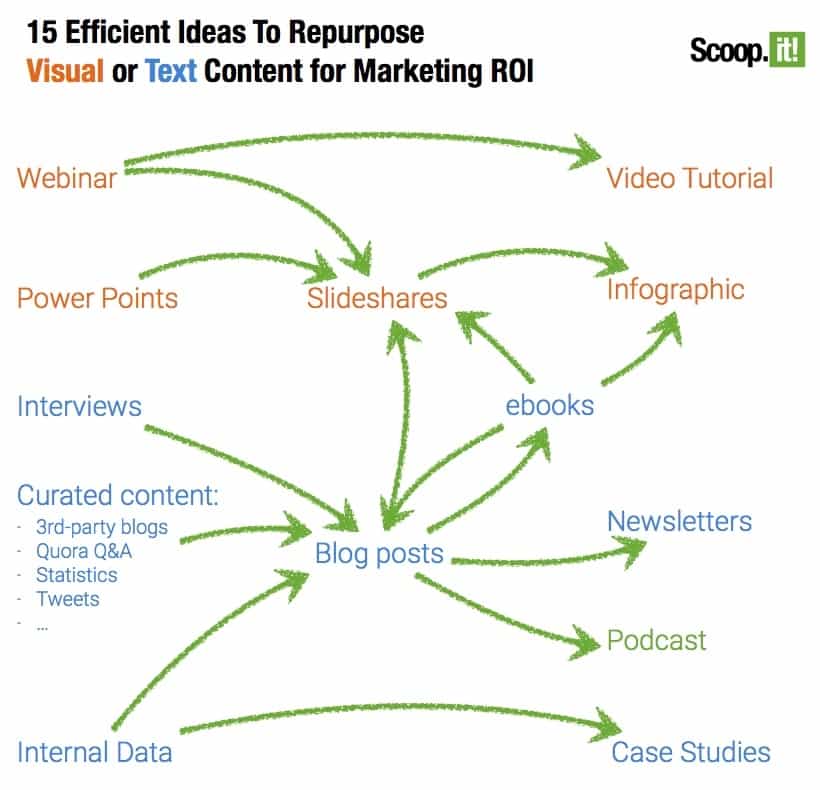
Rethinking your content strategy and creating evergreen content will reduce the time you need to create effective content. Reusing your content via syndication, exposes it to a fresh audience. Recycling your content into different formats reduces your time producing new, original, and high-quality content. Learn more below…
The 3 R's of Blogging
We’re all familiar with the moto, reduce, reuse, recycle. What could happen if you apply that type of thinking to your content  writing strategy? What if you could reduce the amount of time and money you spend writing original content by rethinking the types of content you produce, reusing your existing content, and recycling it into different formats?
writing strategy? What if you could reduce the amount of time and money you spend writing original content by rethinking the types of content you produce, reusing your existing content, and recycling it into different formats?
REDUCE
When you’re using precious time and creativity to produce content only because you’ve heard that content is king, or that Facebook users expect daily posts, or that you have to generate content to rank higher on search engines, you may be approaching content creation the wrong way.
Ask yourself, how does this piece add value for my customers and clients? How does this article fit into my overall strategy? How will it help my bottom line? Can you as a small business owner, really afford the time to tweet 5 times daily, produce a daily Facebook post and write a weekly article?
The adage “content is king”, is mostly true, but if the article you are producing doesn’t have a well-defined purpose before you start writing, stop writing. Consider quality over quantity. For instance, Brian Dean from Backlinko has managed to get over 1 million unique visits over the past year with just 32 in-depth, super useful posts. Thinking through your strategy can reduce the amount of content that you need to conceive, write, edit and publish. You can reduce your total efforts by producing evergreen content.
Evergreen Content Writing
Evergreen content, as the name implies, is always of interest to an audience. Although evergreen content will take additional time upfront, the benefits of its perpetual relevancy are worth it.

You may be thinking, if it takes more time, how can it reduce my overall efforts? Well, once completed, evergreen content can sit idle and continue to draw interested people to your website, sometimes for years, creating valuable backlinks and potential leads in the process. Evergreen content is a valuable addition to your overall content strategy. Here are a few ideas for your evergreen content:
How to” guides and tutorials – Consider both beginners and advanced.
Resource Guides – Roundup great resources that are available for your customers in one place. Periodically check any links to make sure they still work.
Frequently Asked Questions.
Industry definitions – They typically don’t change over time.
Case Studies.
eBooks – Based on topics that don’t change much over time.
Although an evergreen article will benefit your audience over a longer period, remember to periodically revisit it, and make sure that it’s up to date. Your content writing strategy is one of the main cornerstones of your overall digital marketing strategy, so, read on to learn more about how to reuse your content with republishing and recycling.
REPURPOSE YOUR WRITING
Writing effective content that produces results takes time or money. It typically takes both. Brainstorming ideas for new content and ensuring it’s effective can be a tedious task. So, why not make the most of every piece of content you create? By including repurposing tactics into your overall content writing strategy will allow you to reduce your efforts while ensuring your content is not just a one-off opportunity to reach your customers. Repurposing content allows you to reduce the amount of content you need to create by recycling it into new content and reusing it to reach a new audience (potential clients and customers).
So, what exactly is repurposing? Well, it entails reusing and/or recycling your work – adapting it to a completely fresh format and delivering it to a fresh new audience. Like using the same ingredients for a different recipe, you can recycle the content you’ve already created, such as text, images, research, and overall idea, and turn, for instance, old blog posts into an e-guide, infographic, or webinars into a YouTube video tutorial. Not only does this make your content strategy more efficient, but you can also reap all the other benefits it comes with!

As a small business owner, there’s already way too much on your plate. When you find yourself trying to juggle other important business goals, objectives, and write articles on top of that, content repurposing is the way to go. Here’s a great example:
In 2013, Joe Pulizzi, the founder of Content Marketing Institute, found himself in a bit of a pickle. He’d already committed to writing and publishing a new book, “Epic Content Marketing”, but strived was hard pressed to take time out to write it.
He was required to write a 50,000 words book – 25 chapters of 2,000 words each – which definitely isn’t an easy task. Every week, Pulizzi produced content for LinkedIn, as well as, his blog at Content Marketing Institute. As the deadline was fast approaching, Pulizzi was able to use those blog posts in his book and, fulfil multiple goals in the process.
Do you see what he managed to do? Not only was he able to give his old content new life, but he was also able to target an entirely different audience through his book. When Pulizzi repurposed his blog posts, he not only diversified his content, he was able to convey the same message across different marketing channels and mediums.
Repurposing content improves your online digital marketing strategy in multiple ways. Fresh content and content rich web sites are important for the search engines, thus increasing your SEO.
Repurposed content also reaches a larger more diverse audience. This fills the sales pipeline and increases conversions. Repurposing also leads to a more refined content strategy by expanding your reach to target audiences that may need the same message, but whose learning style and preferences may vary.

Perhaps the most significant advantage content repurposing has to offer is the way it extends the life of your content. By adapting a single piece of content into a multitude of formats, updating it according to new information, and creating new content from an old piece of work, you give new life to your old work saving time and effort, and ensure it has a fresh new take to it extend its reach to a new audience. It allows you to quickly create new content on a regular basis, providing consistency and reinforcement of your core message through different touch points, all in all, building credibility.
Now that we’ve established why content repurposing should be a part of your content strategy let’s talk about how it’s done. There are two main types of content repurposing: republishing (syndication) and recycling.
REUSE CONTENT
Reuse your content by republishing it on other websites. It starts first by updating a piece of your content, such as an infographic or article to make sure it is current. Once done, you can repost it on client and customer-relevant websites while crediting the original author (that can be you).
You can syndicate (republish) other people’s content as well, just make sure you credit them and use the proper tags. We typically don’t recommend republishing other authors articles on your own site, we typically only do that on certain form of social media, graphics, and only if it is relevant to our own message and our audience.
RECYCLE CONTENT
Apart from republishing or syndicating your content,  you can also choose to recycle it. This means relaying it in a different format while maintaining the underlying theme of the content.
you can also choose to recycle it. This means relaying it in a different format while maintaining the underlying theme of the content.
Another important reason to recycle your content is to create content that targets various stages of the customer journey. For instance, various sections of an existing eBook could easily be repurposed as an infographic or introductory video, which is useful at the awareness stage of your customer journey. Conversely, creating E Books, webinars, and expert guides from existing or planned articles are useful at the evaluation stage, while case studies combined with testimonials are excellent for the decision stage.
Reusing your content by republishing, exposes it to a brand-new audience. Important considering the size of the internet. Recycling your content into different formats reduces the amount of time and effort that goes into producing new, original, and high-quality content. It delivers your message in a form that may be more useful to potential clients and customers whose content preferences are different than you own. Recycling content can also be used to target different stages in the customer journey
Both practices keep your content fresh and that’s important for search engine optimization. It’s all about what makes each audience segment click. Pun intended! With a little up-front strategy formulation, you gain time efficiency, new short and long-term options, new audiences, fresh content, buyer journey targeting, and a full pipeline of warm leads.
Have you ever tried content re-purposing or recycling yourself? Do you have other suggestions on how to make the most out of it? Let us know in the comments below, if we feel it’s a good idea, we’ll update this article and give you credit! How’s that?
